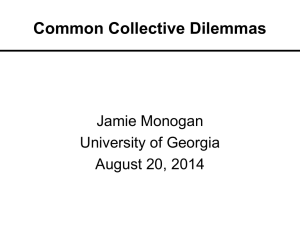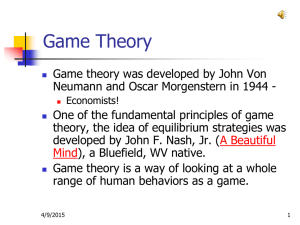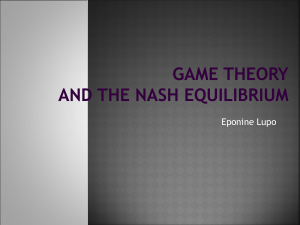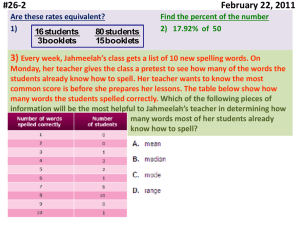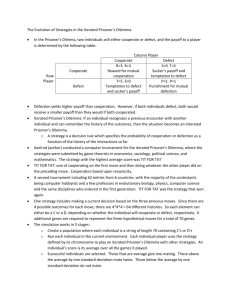theory sum
advertisement
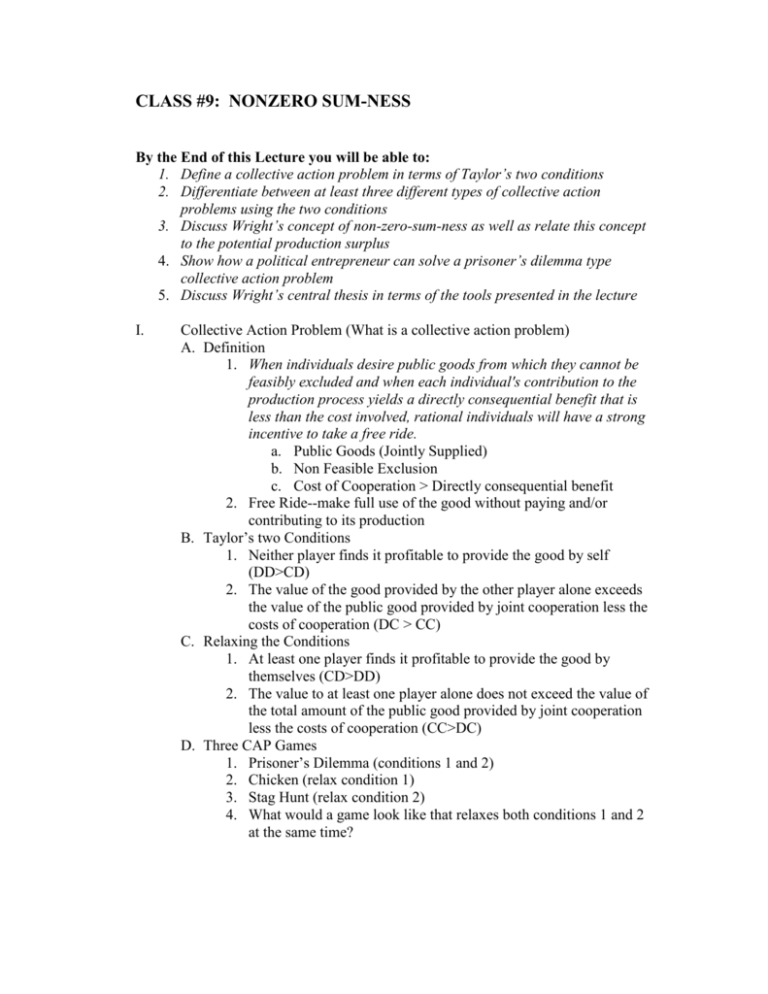
CLASS #9: NONZERO SUM-NESS
By the End of this Lecture you will be able to:
1. Define a collective action problem in terms of Taylor’s two conditions
2. Differentiate between at least three different types of collective action
problems using the two conditions
3. Discuss Wright’s concept of non-zero-sum-ness as well as relate this concept
to the potential production surplus
4. Show how a political entrepreneur can solve a prisoner’s dilemma type
collective action problem
5. Discuss Wright’s central thesis in terms of the tools presented in the lecture
I.
Collective Action Problem (What is a collective action problem)
A. Definition
1. When individuals desire public goods from which they cannot be
feasibly excluded and when each individual's contribution to the
production process yields a directly consequential benefit that is
less than the cost involved, rational individuals will have a strong
incentive to take a free ride.
a. Public Goods (Jointly Supplied)
b. Non Feasible Exclusion
c. Cost of Cooperation > Directly consequential benefit
2. Free Ride--make full use of the good without paying and/or
contributing to its production
B. Taylor’s two Conditions
1. Neither player finds it profitable to provide the good by self
(DD>CD)
2. The value of the good provided by the other player alone exceeds
the value of the public good provided by joint cooperation less the
costs of cooperation (DC > CC)
C. Relaxing the Conditions
1. At least one player finds it profitable to provide the good by
themselves (CD>DD)
2. The value to at least one player alone does not exceed the value of
the total amount of the public good provided by joint cooperation
less the costs of cooperation (CC>DC)
D. Three CAP Games
1. Prisoner’s Dilemma (conditions 1 and 2)
2. Chicken (relax condition 1)
3. Stag Hunt (relax condition 2)
4. What would a game look like that relaxes both conditions 1 and 2
at the same time?
Row Player
Cooperate
Defect
Row Player
Cooperate
Defect
Column Player
Cooperate
Defect
S,S
W,B
B,W
T,T
Column Player
Cooperate
Defect
S,S
T,B
B,T
W,W
Row Player
Cooperate
Defect
Row Player
Cooperate
Defect
Column Player
Cooperate
Defect
B,B
W,S
S,W
T,T
Column Player
Cooperate
Defect
T,T
W,S
S,W
B,B
II.
Non Zero Sum-ness
A. Why is Wright attached to the terminology of game theory?
B. There is no substitute for game theory as a way to look at the history of
our species
C. Cooperation and nonzero sum are not synonyms
1. A nonzero sum relationship is not a relationship in which
cooperation necessarily takes place
2. It is a relationship, which if cooperation did take place, it would
benefit all parties
3. Whether cooperation does take place and the parties realize the
positive sums is an empirical question
D. Nonzero sum-ness is about potential—it can be tapped or not
1. To tap the potential is to realize positive sums that were not there
before
2. It creates more potential
3. Sometimes in nonzero sum situations, the object of the game is to
avoid negative sums
E. Game theory can be used – in conjunction with computer simulation – to
model evolutionary processes
1. Axelrod’s book is the most prominent and uses the prisoner’s
dilemma
2. Wright says use of PD is problematic
a. The object of a PD game is to get the lowest score
b. To not cooperate is to tell the truth; while to cooperate is
not tell the truth
F. Prisoner’s Dilemma – and all nonzero sum games – have the following
important features
1. Communication is important (at least potentially so)
2. Trust is important—you will follow through on your commitments
G. Key things to look for
1. Nonzero sum-ness in principle as potential
2. Ways to achieve potential
3. Role of communication and trust
III.
Potential Production Surplus
A. Definition – The gains that can be realized if there were cooperation
1. Difference between Nash equilibrium outcome and CC
a. Prisoner’s Dilemma – S > T – there is a potential surplus
b. Stag Hunt – S < B – there is a potential surplus
c. Chicken – S < B – there is no potential surplus; however SW – there is a potential surplus
d. Deadlock – T < B – there is no potential surplus
B. Focus on games that have a positive potential surplus
IV.
Political Entrepreneur
A. If groups are to achieve collective goods, they are going to have to
overcome free rider problem and resulting suboptimality.
B. A political entrepreneur is an individual who invests his own time or other
resources to coordinate and combine other factors of production to supply
collective goods.
C. Differences in preferences among collective good recipients lead to
attempts to supply substitute collective goods.
D. Prisoner’s Dilemma Example:
1. Potential Production Surplus
a. Exists whenever S > T so that {S-T} > 0
b. Assume each individual is willing to contribute a portion of
the potential surplus in return for assurance that good will
be produced
c. Total surplus available = {S-T}
2. Solving the CAP
a. PE agrees to provide collective good in return for payment
b. Payment takes the form of "taxes"
c. Is it rational to pay in the following matrix?
Player #2
Player #1
Pay PE
Pay
PE
Do Not
Pay
Do Not Pay
B-tax,B-tax
B-tax,B
B,B-tax
B,B
Prisoner’s Dilemma with Taxes
3. Need for Sanctions
a. Must be separate from the provision of good
b. must be applied individually
c. Sanction = EV[d*(Tax+Penalty)] (where d = probability of
detection)
d. Convergence as long as
a. is sufficiently high
b. Penalty is sufficiently large
Player #2
Player #1
Pay PE
Pay
PE
Do Not
Pay
B-tax,B-tax
B-sanction,
B-tax
Do Not Pay
B-tax,
B-sanction
B-sanction,
B-sanction
Prisoner’s Dilemma with Taxes and Sanctions
E. Stag Example:
1. Potential Production Surplus
a. Exists whenever S > T so that {S-T} > 0
b. Assume each individual is willing to contribute a portion of
the potential surplus in return for assurance that good will
be produced
c. Total surplus available = {S-T}
2. Solving the CAP
a. PE agrees to provide collective good in return for payment
b. Payment takes the form of "taxes"
c. Is it rational to pay in the following matrix?
V.
Wolf’s Dilemma
Twenty people sit, each in a cubicle, with a finger on a button
Each person will get $1,000 after ten minutes, unless someone pushes the
button, in which case the person who pushes the button will get $100 and
everybody else will get nothing
If you are clever you do not push the button and get $1,000
But if you are very clever, you see that there is a tiny chance that
somebody will be stupid enough to push hi or her button
In that case you are better off pushing yours first
If you are very, very clever you see this and push your button
Collective disaster
Cooperation is a frequent feature of human society
Trust is the very foundation of social and economic life
Is it irrational?
Do we have to override our instincts to be nice to each other?
Does crime pay?
Are people only honest when it pays them to be so?
VI. Wright’s Central Thesis
“My contention is that, if we want to see what drives the direction of both human
history and organic evolution, we should apply the perspective of game theory
systematically. Interaction among individual genes, or cells, or animals, among
interest groups, or nations, or corporations, can be viewed through the lens of
game theory. What follows is a survey of human history, and of organic history,
with those lenses in place. My hope is to illuminate a kind of force – a non-zerosum dynamic – that has crucially shaped the unfolding of life on earth so far.”
“As history progresses, human beings find themselves playing non-zero-sum
games with more and more other human beings. Interdependence expands, and
social complexity grows in scope and depth.”
What is the role of government in this dynamic?
Can it get started without the “hidden hand” of government?
